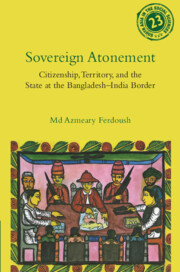Book contents
- Frontmatter
- Contents
- List of figures
- Preface
- Acknowledgments
- Introduction: Remnants, nations, and the sovereign
- 1 Sovereign atonement
- 2 From “sensitive” to “symbolic” spaces
- 3 Land and citizenship as technologies of territory
- 4 Everyday governance: Ambiguity, accountability, and abundance
- 5 Infrastructure, belonging, and the state
- 6 Refusal and tolerance
- Epilogue
- Appendix: A note on methods
- References
- Index
3 - Land and citizenship as technologies of territory
Published online by Cambridge University Press: 30 April 2024
- Frontmatter
- Contents
- List of figures
- Preface
- Acknowledgments
- Introduction: Remnants, nations, and the sovereign
- 1 Sovereign atonement
- 2 From “sensitive” to “symbolic” spaces
- 3 Land and citizenship as technologies of territory
- 4 Everyday governance: Ambiguity, accountability, and abundance
- 5 Infrastructure, belonging, and the state
- 6 Refusal and tolerance
- Epilogue
- Appendix: A note on methods
- References
- Index
Summary
The first time I had ever been to the enclaves was in the early 2000s, not for academic purposes but out of curiosity, as I kept hearing about these “weird” pockets of Indian land located inside Bangladesh. Access was easier for me because I was born and raised in the northern region of Bangladesh, which hosted all these enclaves. I also had friends and relatives living closer to the enclaves. My first visit to the enclaves in an academic capacity was between 2009 and 2010 as a final-year bachelor's degree student doing my undergraduate capstone thesis. My next visit was in 2015 to undertake summer research for my doctoral dissertation. All these trips were before the enclaves were exchanged and accepted as regular Bangladeshi territories. By the time I started my year-long fieldwork in 2017–2018, I therefore already had preconceived ideas about the enclaves. Of course, many changed. However, there were a few scenarios that immediately grabbed my attention, both because they were not what I had expected and because they were surprisingly similar across the enclaves. Many marketplaces and public gathering spaces were renamed. Furthermore, there was a mushrooming of schools, madrasas (educational institutions following an Islamic curriculum), and youth and sports clubs. They all shared some characteristics. These were primarily makeshift structures made with tin and bamboo, often incomplete, with no or insufficient furniture and locked from the outside. However, they all had a signpost describing their names, types, and the year they were founded. The signposts and the patched-together structures they represented immediately “spoke” to my internal “geographer.” They were all founded in 2015 or 2016, just after the enclaves were absorbed as regular Bangladeshi territories. Most of the names were strategically chosen to signify a strong sense of belonging to the state of Bangladesh and drew from either the first PM of the country, Sheikh Mujibur Rahman, or one of his family members assassinated in a military coup in 1975. They were supposed to be emotionally appealing to the then Bangladeshi PM, Sheikh Hasina, the daughter of Sheikh Mujib – one of the two surviving family members from the coup. For example, the most common to come up were Sheikh Russel followed by Sheikh Fazilatunnesa, the PM's youngest brother – a toddler when assassinated – and her mother, respectively, as demonstrated in Figure 3.1.
- Type
- Chapter
- Information
- Sovereign AtonementCitizenship, Territory, and the State at the Bangladesh-India Border, pp. 63 - 87Publisher: Cambridge University PressPrint publication year: 2024



